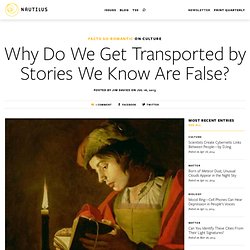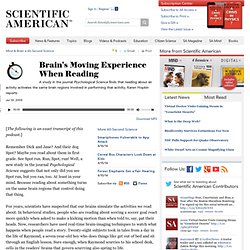

Why Do We Get Transported by Stories We Know Are False? In Jasper Fforde’s lighthearted “Thursday Next” series of books, people can use a “prose portal” to enter the world of a book, to change the plot or kidnap a character.

The prose portal is an imaginative metaphor for a familiar experience: feeling taken away by a narrative, sucked into a good book so that we forget about our actual surroundings. This phenomenon is called “transportation,” and it’s common and revealing enough that scientists have done a lot of research on it, as I described in my post yesterday. Getting lost in a good book is a bit like getting lost in your own daydream—it is an act of imagination, in which we mentally simulate events and experience them as a kind of organic virtual reality. With literary transportation, though, it is a guided imagination, where the simulation is led and constrained by the text. Why People Love to Get Lost in Books. In the huge range of different human cultural inclinations, one of the most widespread is a fondness for stories.

We just love to get lost in a good book or movie. When we do, we tend to ignore where we are and become completely absorbed in the story. Psychologists call this “transportation,” and have conducted ingenious experiments to figure out what makes a story compelling, why people seek out transportation, and what kinds of people are more likely experience the feeling. Transportation is connected with the powerful idea of flow: that pleasurable feeling you get when you are completely absorbed in an activity, and lose track of time. Reading, it turns out, is the most common activity people pursue to get a flow experience. Temporarily leaving one’s reality sometimes feels very pleasing, and people will often choose to engage with particular narratives for their mood-management effects.
One thing stories are good at is helping understand others’ points of view. The Reading Brain in the Digital Age: The Science of Paper versus Screens. In a viral YouTube video from October 2011 a one-year-old girl sweeps her fingers across an iPad's touchscreen, shuffling groups of icons.

In the following scenes she appears to pinch, swipe and prod the pages of paper magazines as though they too were screens. When nothing happens, she pushes against her leg, confirming that her finger works just fine—or so a title card would have us believe. The girl's father, Jean-Louis Constanza, presents "A Magazine Is an iPad That Does Not Work" as naturalistic observation—a Jane Goodall among the chimps moment—that reveals a generational transition.
"Technology codes our minds," he writes in the video's description. "Magazines are now useless and impossible to understand, for digital natives"—that is, for people who have been interacting with digital technologies from a very early age. Perhaps his daughter really did expect the paper magazines to respond the same way an iPad would. Your Brain on Books. Stanislas Dehaene holds the chair of Experimental Cognitive Psychology at the Collège de France, and he is also the director of the INSERM-CEA Cognitive Neuroimaging Unit at NeuroSpin, France’s most advanced neuroimaging research center.

He is best known for his research into the brain basis of numbers, popularized in his book, “The Number Sense.” In his new book, “Reading in the Brain,” he describes his quest to understand an astounding feat that most of us take for granted: translating marks on a page (or a screen) into language. He answered questions recently from Mind Matters editor Gareth Cook. COOK: How did you become interested in the neuroscience of reading? DEHAENE: One of my long-time interests concerns how the human brain is changed by education and culture.
COOK: What is this “new relationship”? What I am proposing is that the human brain is a much more constrained organ than we think, and that it places strong limits on the range of possible cultural forms. Brain's Moving Experience When Reading. [The following is an exact transcript of this podcast.]

Remember Dick and Jane? And their dog Spot? Maybe you read about them in first grade. See Spot run. Run, Spot, run! For years, scientists have suspected that our brains simulate the activities we read about. Fortunately, the copycatting is confined to the brain—we don’t actually act out the things we read about. —Karen Hopkin. Reading Braille Activates the Brain's Visual Area. Does a blind person reading Braille process words in the brain differently than a person who reads by sight?

Mainstream neuroscience thinking implies that the answer is yes because different senses take in the information. But a recent study in Current Biology finds that the processing is the same, adding to mounting evidence that using sensory inputs as the basis for understanding the brain may paint an incomplete picture. Researchers in Israel, Canada and France used brain imaging to observe the neural activity of eight blind subjects as they read Braille. They found that although the blind subjects were using their sense of touch, their brains showed activity in the same so-called visual region that sighted people use when they read.